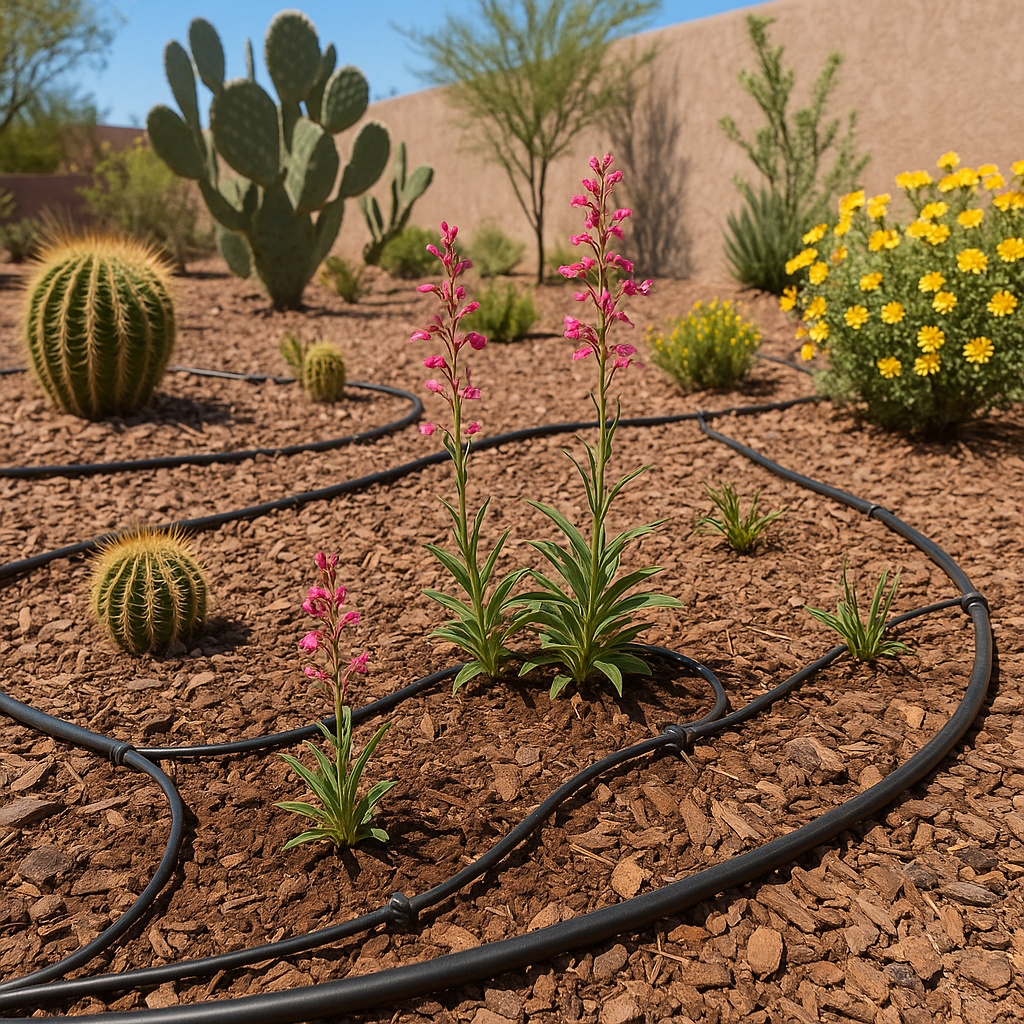
Spring in Gilbert, AZ signals the start of serious yard care season—and a thorough irrigation tune-up can make or break how your landscape performs through the hot, dry months ahead. Whether you’re managing drip lines, sprinklers, or a hybrid setup, prepping your system now ensures water efficiency, plant health, and peace of mind.
💧 Why Spring Irrigation Tune-Ups Matter in Gilbert
With summer highs routinely topping 100°F, water conservation isn’t just smart—it’s essential. Gilbert’s desert climate and local water use ordinances demand efficient irrigation. A neglected system can overwater some areas, underwater others, and waste hundreds of gallons a week. By conducting a tune-up now, you’ll reduce waste, avoid plant stress, and stay compliant with city conservation guidelines.
🧰 Step-by-Step Irrigation Tune-Up Checklist
- ✅ Inspect the Controller: Confirm it’s set to Gilbert’s time zone and programmed for spring. Consider upgrading to a weather-based controller that adjusts to temperature and rain forecasts.
- ✅ Run Each Zone Manually: Observe every sprinkler head and drip line. Look for misalignment, overspray onto hardscapes, or emitters that are clogged or leaking.
- ✅ Flush & Clean Filters: Especially important in Gilbert where water can carry sediment. Clean screen filters and flush drip lines thoroughly to maintain even pressure.
- ✅ Inspect Pressure Regulators: Check each valve or emitter zone for correct pressure. Drip systems typically perform best at 20 psi; sprays at 30 psi.
- ✅ Check for Leaks & Wet Spots: Soft or muddy patches in your yard often signal underground leaks or broken components. Use moisture meters to confirm.
- ✅ Reposition Sprinkler Heads: Heads may shift over winter. Realign for complete coverage and avoid spraying onto sidewalks or windows.
- ✅ Update Watering Schedule: Early morning watering (4–6 a.m.) minimizes evaporation. Use Gilbert’s Water Conservation Guide to tailor frequency by plant type.
🚀 Smart Upgrades for Greater Efficiency
Modernizing your irrigation system pays off quickly in Gilbert’s dry climate:
- Smart Controllers: Wi-Fi-enabled systems use local weather data to automate watering adjustments. Brands like Rachio and Hunter Hydrawise work well in Arizona conditions.
- Rain/Freeze Sensors: Prevent watering during rain or freezing nights—especially valuable during late winter and early spring transitions.
- Soil Moisture Sensors: Reduce overwatering by delivering water only when the soil is dry.
- Check Valves: Prevent system drainage after shutoff, especially on slopes.
- Pressure-Regulating Sprinkler Heads: Maintain even output regardless of elevation changes across your landscape.
📅 Seasonal Watering Schedule for Gilbert (Zone 9b)
Adjusting your schedule seasonally improves plant health and prevents waste:
- 🟢 March–April: Begin spring watering. Increase frequency gradually as temperatures rise. Check for early weed growth in damp areas.
- 🔴 May–June: Water deeply 2–3 times a week. Use the “cycle and soak” method for clay soil to prevent runoff.
- 🌧️ July–August: Gilbert’s monsoon season. Turn off your system when storms roll through. Monitor for fungal issues from excess moisture.
- 🍂 September–October: Reduce frequency as temperatures drop. Fall is ideal for re-seeding and fertilization.
⚠️ Common Mistakes Homeowners Make
- Overwatering: The top cause of turf disease and water waste. Use a soil probe to test moisture before watering again.
- One-size-fits-all schedules: Shaded areas need far less water than sunny ones. Adjust by zone based on microclimate.
- Ignoring runoff: Runoff wastes water and can cause erosion. Use short bursts with soak time in between for compacted soils.
🌿 Pro Tips for a Healthier Landscape
- Install drip irrigation for shrubs and trees—it’s more efficient than sprays.
- Top dress with compost in spring to improve soil structure and water retention.
- Log your changes and upgrades in a garden journal or spreadsheet to track system performance year over year.
🔗 Related Articles
- How to Prevent Overwatering in Gilbert
- Simple Sprinkler Upgrades for Gilbert Yards
- Gilbert’s Most Common Lawn Weeds
📚 Local Resources for Gilbert Homeowners
❓ Frequently Asked Questions
- When should I perform a spring tune-up?
- Late March to early April is best in Gilbert—just before daytime temps spike and before monsoons affect scheduling.
- How do I know if I’m overwatering?
- Spongy soil, visible runoff, and yellowing plants are signs. Check moisture with a screwdriver or soil probe.
- Is it worth hiring a pro?
- Yes—especially for large yards or if your system hasn’t been checked in a few years. Professionals can perform flow tests, wiring diagnostics, and optimize coverage.
Pro Tip: Label zones and valves and store a map of your irrigation system layout. It makes repairs and maintenance easier year-round.





